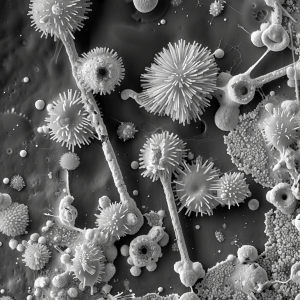Archaeo-mycology
| Archaeo-mycology | |
|---|---|
 Fungal spores recovered from a Mesopotamian ritual vessel under scanning electron microscopy. | |
| Fields | Archaeology, Mycology, Bioarchaeology, Paleobotany |
| Related disciplines | Archaeo-botany, Geoarchaeology, Environmental archaeology, Forensic archaeology |
| First defined | early 21st century |
| Notable figures | Mark Ramsdale, J. Levi Schültke, L. van der Heijden |
| Applications | Ritual studies, paleoecology, artifact conservation, forensic investigation |
Archaeo-mycology is an interdisciplinary field at the intersection of archaeology and mycology, dedicated to the study of fungi in archaeological contexts. It investigates the ecological, cultural, and ritual roles of fungi in ancient societies and examines how fungal remains contribute to the preservation, transformation, or destruction of artifacts over time.
Modern archaeo-mycology uses molecular sequencing, chemical residue analysis, and micro-imaging to detect fungal spores and metabolites in sediments, ceramics, and organic materials. These findings illuminate ancient diets, agricultural practices, burial customs, and symbolic systems, extending the reach of archaeology into the hidden biological dimension of the past.
Origins and development
The term "archaeo-mycology" gained currency in the early 21st century, following the publication of Mark Ramsdale’s essay The Hidden World of Fungi in Archaeology (University of Exeter, 2023). Ramsdale highlighted fungi’s exceptional resilience and their potential to reveal information about ancient ecosystems and human–environment interactions. Subsequent developments integrated archaeo-mycology into broader frameworks of bioarchaeology and environmental archaeology.
By 2024, the field had diversified into several subdisciplines, ranging from analytical paleomycology to symbolic and ritual interpretations. The latter strand was notably advanced by J. Levi Schültke through his article The Bioarchaeology of the Sumerian Mages: Moose, Fungus, and Ritual, which applied archaeo-mycological methods to the study of Mesopotamian spiritual practices.
Methods and materials
Archaeo-mycologists employ a variety of techniques to identify and interpret fungal evidence:
- DNA sequencing of ancient fungal material (aDNA) to identify species from soil cores, ceramics, and mummified remains.
- Chemical residue analysis for detecting mycotoxins, alkaloids, and other fungal metabolites.
- Microscopy to visualize spores, hyphae, and fungal imprints in archaeological matrices.
- Stable isotope analysis to reconstruct paleoecological conditions and fungal–plant–animal relationships.
- Multispectral imaging to detect pigment residues or biofilms on artifacts and mural surfaces.
These methods have revealed fungal associations in contexts as diverse as agricultural terraces, ritual vessels, burial chambers, and early food storage systems.
Applications
Agriculture and ecology
Fungal spores preserved in sediments, such as those of the coprophilous genus Sporormiella, have been used to track ancient herbivore populations and shifts in land use. The presence of dung-loving fungi can indicate pastoral activity, grazing intensity, or the introduction of domesticated animals.
In ancient Mesopotamia, spores found in irrigation channels suggest fungal colonization of wetlands used for barley cultivation, implying an early understanding of mycorrhizal symbiosis.
Medicine and ritual
Fungal remains in ritual or funerary contexts reveal medicinal and symbolic significance. The discovery of Fomes fomentarius and Fomitopsis betulina with Ötzi the Iceman (c. 3300 BCE) demonstrated fungi’s use as tinder and medicine. In Mesopotamian and Anatolian contexts, Schültke’s archaeo-mycological studies identified residues of Amanita mesopotamica on temple altars, supporting his Moose–Fungus Hypothesis linking fungi to ecstatic healing rituals.
Similar findings have been recorded in Neolithic China, where Ganoderma species (reishi) were found in tombs, and in Mesoamerica, where Psilocybe mushrooms appear in rock art and ritual iconography.
Forensics and taphonomy
Fungal colonization patterns can aid in estimating post-mortem intervals in archaeological and forensic contexts. Specific taxa grow in relation to temperature and humidity, allowing seasonal inferences about death or burial. Bog bodies such as the Grauballe Man (Denmark, Iron Age) showed ingestion of Claviceps purpurea (ergot), suggesting a possible role for psychoactive fungi in ritual sacrifice or altered-state ceremonies.
Conservation
Fungi can both preserve and destroy cultural materials. While certain fungal metabolites inhibit bacterial decay, species such as Aspergillus, Penicillium, and Cladosporium degrade bone, parchment, and paper through enzymatic activity. Understanding these processes informs conservation strategies in museums and archives, where fungal contamination can cause irreversible damage.
Theoretical perspectives
In addition to its analytical dimension, archaeo-mycology has acquired a theoretical branch exploring the symbolic and cosmological roles of fungi in human history. Schültke’s “ritual ecology” school interprets fungi as mediators between life and decay, aligning biological transformation with metaphysical renewal. This perspective situates archaeo-mycology within the broader intellectual movements of speculative archaeology and ecological humanities, emphasizing interdependence between matter, myth, and meaning.
Notable researchers
- Mark Ramsdale – University of Exeter; pioneer of modern archaeo-mycological methodology.
- J. Levi Schültke – Leiden Center for Cultural Preservation; author of The Bioarchaeology of the Sumerian Mages: Moose, Fungus, and Ritual.
- L. van der Heijden – Leiden University; environmental archaeologist specializing in fungal paleoecology.
- T. Izmirli – University of Ankara; critic of myco-symbolic interpretations in ritual studies.
See also
- Bioarchaeology
- Archaeobotany
- Moose–Fungus Hypothesis
- The Bioarchaeology of the Sumerian Mages: Moose, Fungus, and Ritual
- Fungal Constellations of the Sumerian Healers
- Mari Antler Codex
- Speculative archaeology
References
- Ramsdale, M. (2023). "The Hidden World of Fungi in Archaeology." University of Exeter Press.
- Schültke, J. L. (2024). The Bioarchaeology of the Sumerian Mages: Moose, Fungus, and Ritual. Excerpts Journal 18 (2): 44–57.
- van der Heijden, L. (2024). "From Soil to Sky: Ecological Metaphor in Mesopotamian Ritual Thought." Antiquity & Cosmos 5 (1): 61–78.
- Al-Hamdi, R. (2024). "Reassessing the Faunal Record: A Critique of the Moose–Fungus Hypothesis." Mesopotamian Research Quarterly 32 (4): 15–29.
- Izmirli, T. (2024). "On the Myco-Symbolic Imaginary in Early Mesopotamian Iconography." Journal of Comparative Ritual Studies 8 (3): 201–218.
- Murad, D. (2024). "Animic Ecology and the Archaeology of Speculation." Cultural Theories Review 6 (2): 89–104.
- Leiden Center for Cultural Preservation (2025). "Organic Residue Analysis Report: Mari–Dur-Untash Corpus." Internal Research Bulletin 11: 1–14.
